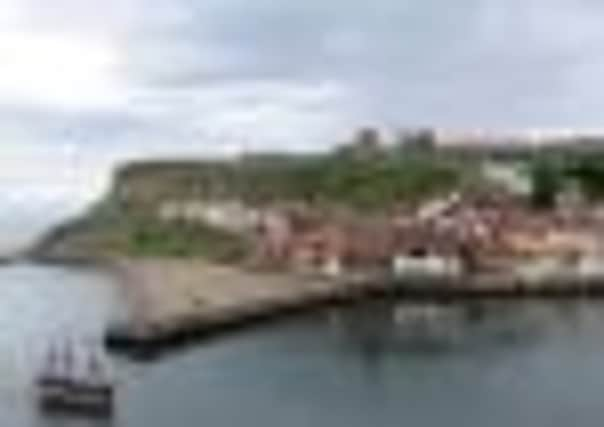Town that will not die


More than a century after Bram Stoker dreamed up Dracula – helped by nightmares brought on by ill-digested seafood – Whitby continues to enjoy a healthy tourism stake in the greatest horror story ever told.
Just when it seemed every aspect of the Gothic spine chiller had been plundered by film makers, a new blockbuster is planned, focusing on the doomed vessel that brought the count to the shores of Yorkshire.
Advertisement
Hide AdAdvertisement
Hide AdThe Last Voyage of the Demeter aims to provide a new twist to the legend by concentrating on the last hours of the crew as their devilish passenger picks them off one by one en route to Whitby.


With stars such as Jude Law and Ben Kingsley in talks with producers, many in Whitby are already shaking their heads and warning it can only lead to more ghoulish visitors turning up in St Mary’s Church Yard asking for “Dracula’s grave” (the answer from locals is “He is buried next to Donald Duck” – to which many a disappointed vampire hunter has objected: “But Donald Duck’s not real”).
Ironically, Stoker’s notes have revealed that he originally planned for the Count to enter Britain via Dover. But all that changed when he and his wife Florence and son Noel booked a three-week holiday in Whitby in the July of 1890 and the author stumbled across a fleeting reference to Dracula in the local library.
Ever since, Whitby has been famous as the “birthplace” of Dracula – though many have felt that it has overshadowed the many other attractions of the town for too long.
Advertisement
Hide AdAdvertisement
Hide AdHad Stoker never written a line about Whitby visitors would still come to see the magnificent monuments to Captain Cook and the Father of English poetry, Caedmon.
The town is also home to some of the best fish and chips, scampi and kippers in Britain, and a magnificent Abbey, the site of the 664AD Synod of Whitby, which fixed the date of Easter. Much revamped by English Heritage over recent years, the ruin now houses a wealth of interactive displays to bring its past to life.
It has become a symbol of the regeneration of a tourism industry which continues to be backbone of the local economy despite cuts affecting its winter opening times. Some of Yorkshire’s brightest tourism gems are to found in Whitby – St Mary’s Church, the 199 steps, the revamped Pannett Park…the list goes on and on.
Many visitors are just content to wander its maze of cobbled streets with its cosy cafes, pubs, and jet shops or indulge a sweet tooth in the many confectionery businesses.
Advertisement
Hide AdAdvertisement
Hide AdMuch of the Old Town would still be recognised by the young Captain Cook, who learned his seamanship in Whitby, and Charles Dodgson, who as Lewis Carroll imagined his Alice on his frequent visits. In many ways, it is still the town of Cook, mariner William Scoresby, lifeboat hero Henry Freeman, St Hilda, Caedmon and other famous visitors.
But there is a side to Whitby that the summer visitors drawn to the boats bobbing in the harbour do not see – job losses on its industrial estate and the decline in fishing.
Coun Dorothy Clegg said: “We are down to four deep-sea fishing vessels and they are all up for sale. Quotas are crippling fishing in Whitby. I came to a working harbour 40 years ago. We have lost the cargo trade and shops on the east side are closing in front of my eyes.”
It is a sign of the times that Whitby’s historic Town Council, founded 1894, is considering leaving the fold of Scarborough Borough Council and throwing in its lot with the North York Moors National Park Authority.
Advertisement
Hide AdAdvertisement
Hide AdBut a ray of hope is the off-shore energy market. The Dogger Bank zone, an area the size of North Yorkshire earmarked to deliver a quarter of Britain’s electricity needs by 2020, is less than three hours steaming from Whitby.
Scarborough Council Derek Bastiman, Cabinet member for strategic planning and regeneration, believes the servicing, maintenance and training opportunities could send a wind of change through the jobs market.
He said: “The opportunity of developing renewable energy production on the scale proposed will be of benefit to everyone.
“We have a great workforce, land ready for development with the infrastructure and skills in place. Our existing engineering industry is at the leading edge of many technologies, and they are well networked and eager to get involved.”
Advertisement
Hide AdAdvertisement
Hide AdThere are clearly challenges ahead and a growing feeling that the Whitby economy needs to be less geared towards tourism and more towards providing quality jobs in hi-tech industries, particularly for young people.
However, it is a road Whitby has travelled before. In the 1990s, buoyed up by the visits of HM Bark Endeavour, Whitby clawed its way back from being North Yorkshire’s worst unemployment blackspot to one of the UK’s top tourism destinations.
The town might have been as close to dead as its fictional visitor from Transylvania – but, just like Stoker’s enduring creation, it has always refused to lie down.
WHITBY’S LIFEBLOOD WITHOUT THE COUNT
* Whitby jet was laid down in the mid Jurassic period. Decayed Monkey Puzzle trees mixed with mud and mineral deposits on the sea bed was squeezed by immense pressure and fossilised. Queen Victoria made it fashionable during her long mourning for Prince Albert.
Advertisement
Hide AdAdvertisement
Hide Ad* Whaling became a new local opportunity in 1753 when two ships set sail for Greenland. Boiler houses were built alongside the harbour to boil down blubber into oil until the industry collapsed 80 years later.
* Whitby’s whale jaw archway was donated by a Norwegian, Thor Dhal and the artist Graham Leach, in 1963. It was replaced in 2002 with bones from Whitby’s sister town, Anchorage in Alaska.